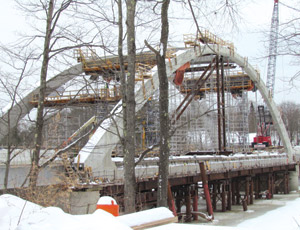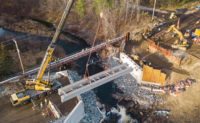The new $21.5-million Norridgewock Bridge—one of only two modern tied-arch concrete bridges to be built in the U.S.—is taking shape over the Kennebec River in northern Maine.

The new bridge includes a 300-ft center span and two 150-ft approach spans. Four of six transverse braces are now in place, along with 19 intermediate floor beams and three end beams. When opened this fall, it will replace a four-span concrete tied-arch bridge built in 1928, which was one of the first of its kind in the U.S., says Craig Weaver, senior project manager with designer Kleinfelder, San Diego. Kleinfelder worked with the contractor to modify the construction sequence. “Typically, there’s little on-site involvement from designers,” says Weaver. “But [the Maine Dept. of Transportation] gave us an extra fee to support their resident engineers because it is such a complex job.”
In preliminary design work, Kleinfelder sought to mimic the historic design of the aging bridge with a three-span replacement bridge, including the tied-arch center span of precast and cast-in-place concrete as well as two 135-ft precast-concrete approach spans. Research uncovered only one other bridge with the same design: a 300-ft main-span concrete tied-arch bridge, in Rogue River, Ore.
Kleinfelder determined it could not replace the four-arch bridge structure with a conventional modern design. “We looked at cost, local interest and the historic significance of the bridge and recommended replacing the original with a much larger concrete tied-arch bridge,” Weaver says.
Kleinfelder performed structural modeling of the bridge using a software program for analysis and design with an added dimension that rendered the effect of time on materials, such as creep, shrinkage relaxation and elastic shortening. “We design for now, and we can check predictions for the effects of time over 50 years,” Weaver says.
General contractor Reed & Reed Inc., Woolwich, Maine, will post-tension the hangers, then use hydraulic jacks to lower the tie girders before removing the formwork. “It’s getting warmer, but we still have 20-plus inches of ice with 16 to 18 inches of good black ice,” says Ted Clark, Reed & Reed project manager. One challenge was a wire hanging system using 5.5-in.-thick threaded rods in the arch. “We had to screw nuts weighing 40 pounds into sockets on 3-inch-diameter wire cables,” Clark says.
Catherine Mettey, MDOT resident engineer, says the new bridge includes a 25-ft-high transverse brace that will allow for better clearance. “We have had problems with logging trucks hitting cross members on the old bridge,” she says. Currently, traffic is flowing across a detour east of the new bridge on Maine Route 108, Mettey says.



Post a comment to this article
Report Abusive Comment